CrossFit Group Class Coaching Expectations: Coaching
 Tuesday, June 24, 2014 at 12:00AM
Tuesday, June 24, 2014 at 12:00AM 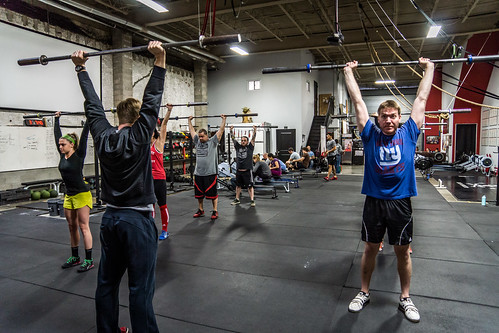
CrossFit founder and CEO Greg Glassman once said: “I can tell you what it is that makes you successful in business, more specifically as a CrossFit affiliate. It’s the blind and relentless constant pursuit of excellence.” On ITA, we never get tired of talking about what we think makes an excellent CrossFit coach. Last year, I wrote about how as an affiliate owner, your coaches are the most important resource you can leverage—they are the brick and mortar of what will make your business solid. Earlier this year, I wrote an open letter to new coaches, emphasizing a few basic principles for getting started on one’s career. And a few months ago, ITA profiled one of CFSBK’s coaches, who shared 10 pieces of advice for other coaches.
Today, we’re continuing on in our series about the concrete expectations I have for CFSBK’s coaching staff during group classes, and these six categories below cover all the behaviors—specific to the unique, complex art of coaching—that I believe every professional CrossFit coach should embody during classes. Each of these categories reflects CFSBK’s own constant pursuit of excellence, and hopefully there will be plenty of crossover for your situation as a coach or affiliate owner.
Coaching
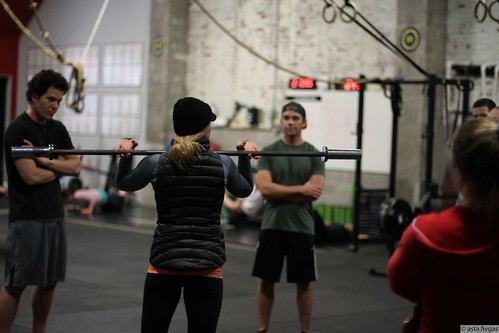 1. Coaches should provide clear and effective progressions during coach-led segments.
1. Coaches should provide clear and effective progressions during coach-led segments.
Teaching motor control is both a science and an art. Movement progressions should work with a sort of layering effect, building gradually from basic positions into more complex sequences. Part of coaching involves understanding how people best learn new movements and organizing progressions accordingly. While most of CFSBK’s group class coaching progressions are determined well before each individual group class, coaches need to understand in general how to execute effective sequences for all exercises.
At CFSBK, for example, barbell hang snatch warm-ups might look something like this:
Two sets of:
5 Behind the Neck Snatch Grip Push Presses
5 Overhead Squats to your lowest stable position
---rest
Two sets of:
5 Hang Muscle Snatches
5 Hang Power Snatches + OHS
---rest
Two sets of:
5 Hang Squat Snatches
The first couplet warms up the basic ranges of motion seen in the movement and does not require high levels of coordination. This is also the time where athletes can identify the depth at which they’re able to catch their snatches, which may vary due to mobility limitations.
The second couplet introduces both where athletes should begin the movement and how they should move their arms during the third pull. By not including footwork yet, we can solely focus on the static start position followed by the transition overhead. Then we put a segmented version of the whole movement together by separating the hang snatch from the overhead squat.
Again, in general, coaches should know how to structure a progression based on the movement or needs of individual athletes, and coaches should be able to explain why they chose said progressions and modifications.
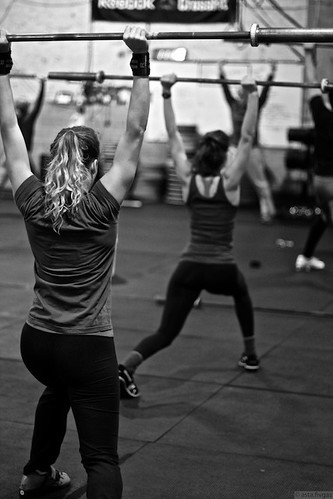 2. Coaches should control tempo and positions of everyone during coach-led reviews.
2. Coaches should control tempo and positions of everyone during coach-led reviews.
Getting everyone in class to move together is critical for controlling the flow of a progression, and for maximizing your ability to communicate with the entire group. The ability to orchestrate this does not come intuitively to new coaches and takes a bit of practice to figure out. During coach-led warm-up segments, athletes will usually be holding a start position (like standing ready to push press), then moving through a transition (executing the dip/drive and thrust overhead) before finishing in another stable end position (a complete locked out position). The coach’s goal should be to create uniformity in these positions at all points of the led movement progressions. If a few people are holding the rack position, while a couple others are listening with the bar down at their hips, and yet another dude is actually practicing the movement at his own pace, the coach has lost the group, which decreases the efficacy of the class.
Keeping everyone on the same page during group classes is strongly linked to being a confident communicator, which we wrote about last week. But a few “pro tips”:
- Making eye contact with individual athletes and repeating the position is an easy way to get stragglers up to speed without losing the flow of what you’re saying.
- On a visual level, people will naturally mime the coach’s positions, so coaches should always start a progression or series of reps by performing the movements themselves at tempo with the group.
- Getting everyone in the same positions through coaching ensures that athletes can focus on learning the movement, and not be looking around trying to figure out what they should be doing.
Click here to see an example of this.
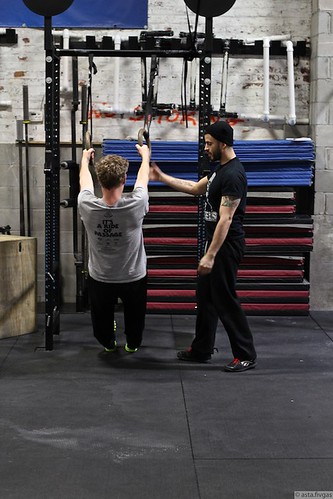 3. Coaches should have the ability to micromanage troubled movers without slowing the rest of the class down, and provide concise solutions for individuals who need it.
3. Coaches should have the ability to micromanage troubled movers without slowing the rest of the class down, and provide concise solutions for individuals who need it.
On a semi-regular basis, group classes will include someone who significantly struggles with a movement due to either motor control issues or range-of-motion restrictions. In extreme cases, these people might need to be triaged such that they require more hands-on help than most people or need to perform something entirely different than the rest of the group. While it’s the coach’s responsibility to make sure that person is safe and getting the help they need, working with them shouldn’t become a vacuum that sucks the coach away from others in the group who also need help. The easiest way to work with someone like this is to touch base with them about what you’re seeing and why it concerns you—then give them a modified version of the movement with specific weight and rep schemes. For example, if a member fresh out of Foundations shows up on a day when the class is cleaning and jerking and they can barely organize the movement, you could abbreviate it to something like this:
“With an empty barbell, start in the hang position and perform 5 muscle cleans focusing on a smooth and compact rack delivery. Then, perform 5 Push Presses holding the top for a 2 count, staying TIGHT!”
Perform 3 sets of this resting about a minute between each set.
This modification gives the athlete a more basic version of what the group is working on, which will reduce likelihood of injury and allow the coach to walk away to work with others before circling back to assess what the person should do next.
4. Coaches should have the confidence to stop and scale improper and unsafe movement, even at the expense of performance results.
Keeping athletes safe is the coach’s top priority. Athletes working beyond their capacity to maintain safe positioning should be addressed immediately, as we discussed above. But if the athlete does not respond to cueing or general feedback, then the coach needs to modify the movement or decrease the load as they see fit. They should communicate with the athlete these following points:
- What they’re seeing (i.e., “Your back is rounding on all these deadlifts”)
- Explain why it’s unsafe (i.e., “This is putting harmful stress onto your back and can likely lead to serious injury if not corrected”)
- Provide a solution (i.e., “Strip 40lbs from this barbell and focus on setting up each rep perfectly, more so than quickly”)
Some athletes will be very grateful for this kind of feedback and adjust accordingly; others may be more resistant to modifying their workout, especially if they feel like they’re moving well or are focused on the result (such as PR-ing a lift or benchmark workout) as opposed to the process of training. Coaches need to be stern and address these situations in accordance with keeping the athlete safe, even if it’s not what the athlete wants or necessitates a tough conversation.
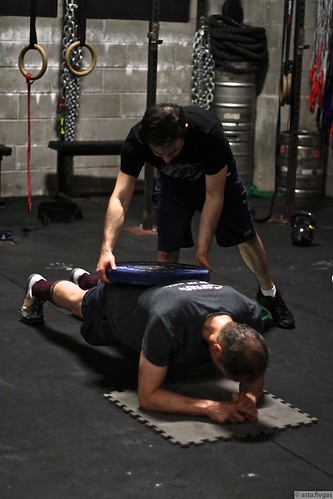 5. Coaches should encourage individuals to scale up when they think it's appropriate.
5. Coaches should encourage individuals to scale up when they think it's appropriate.
On the other side of the spectrum, sometimes athletes need a push to move up in load or work harder during conditioning pieces. Everyone knows that guy or girl who always errs on the side of way too light or easy for their Rx’s. Often this is well-intentioned, as the individual humbly assesses his or herself as not fit enough to handle a heavier load or more advanced movement. They may also simply want to keep themselves safe. But if it’s within their capacity, the coach should both be able to identify it and encourage them to scale up.
If I see an athlete swinging the 16kg kettlebell in “Helen” like it’s a WODToy, I’ll grab a 20kg and exchange the load for them, letting them know they’re moving well and the load is too light for what they need to create a stimulus. These people often will curse at you mid-workout—and sincerely thank you afterwards. Understanding when to pull an athlete back and when to push them forward is the responsibility of every coach.
6. Coaches should deliver prioritized and methodical cueing during warm-ups, lifting, and metcons.
This category is concerned with how effective the coach is at cueing individual athletes. Below are a few bullet points that I emphasize with CFSBK’s coaches:
- Coaches should be clear and concise, avoiding unnecessary verbiage or confusing feedback. Good: “Shove your hips back” Bad: “What I want you to do, is to move your hips the opposite direction of your shoulders”
- Coaching feedback should be triaged accordingly, such that the most germane safety or movement issues are addressed first. For example, someone pulling a deadlift with a flexed lumbar spine and overextended cervical spine should have their lumbar issue addressed first, as it’s more likely to cause an immediate serious injury. Often intelligent feedback can clean up other issues without even needing to directly address them.
- Coaches should modify their coaching feedback if the athlete is not responding. If saying, “Chest up!” doesn’t get someone to find thoracic extension, saying it 10 more times and louder probably won’t do the trick either. The coach should be fluid in modifying their verbal cues or using tactile or visual cues to accomplish the change they want to see in their athlete.
Finally, and I’ll close with this: cueing needs to happen at all times during the class. It doesn’t matter if an athlete is about to attempt a PR clean or doing air squats in a warm-up— the coach should always be walking the floor providing feedback where they see it needed. At no point in any class will everyone be moving perfectly, so there is always an opportunity for improvement in your athletes. I’ve personally dropped in at an affiliate where the “coach” started the clock for the WOD and then sat down on the computer to check their email. This is not a coach, this is a glorified “stop watch operator”. These people do not deserve to be paid for their services or acknowledged as professionals. As we’ve said before, keep working on yourself. As coaches, we each have an opportunity to be part of the force that makes this business even better.

Reader Comments (1)
Thanks David! Again an awesome post on refining our coaching. A lot of this is similar to what you would learn at the CF coaches prep seminar. Good stuff!